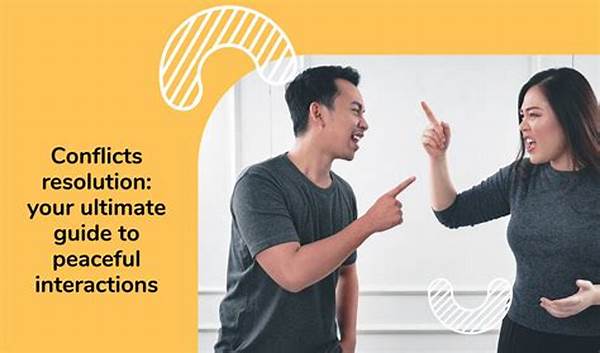Once upon a time, in a quaint little town nestled between towering mountains, two local farmers, Tom and Jerry, found themselves embroiled in a conflict over the stream that ran between their lands. This stream was their lifeline, and both men laid claim to a larger share of the water. Tensions soared, and the community watched as neighbors became adversaries. Then, into the story stepped an astute village elder who proposed something novel: measuring the success of any resolution they might reach. The concept of outcome measurement in conflict resolution was thus introduced to this small town.
Read Now : Streamlining Acting Experience Listings
Understanding the Importance of Measuring Outcomes
The villagers gathered, intrigued by the elder’s idea. With wisdom etched in his eyes, the elder explained that resolving conflicts wasn’t only about reaching an agreement but ensuring that the solution truly worked for everyone involved. Outcome measurement in conflict resolution became the tool to assess the effectiveness of their agreements. Everyone leaned in as the elder painted a picture of sustainable peace, not just a temporary ceasefire, establishing how critical it was to measure the success of their conflicts’ resolutions.
Outcome measurement in conflict resolution provided them with a framework to ensure their agreements didn’t just look good on paper but actually benefited both Tom and Jerry. It allowed them to assess if Jerry was receiving enough water for his crops and if Tom’s livestock were getting their fair share. Through this newfound understanding, the villagers realized that true resolution came when all involved could step away feeling equitable gains had been achieved, forming a harmonious community as a result.
The Process of Measuring Outcomes
1. Initial Impact: The elder recounted the first step: observing the immediate changes that took place after a resolution was signed. Were the waters flowing as agreed? Initial insights were crucial in understanding the groundwork of outcome measurement in conflict resolution.
2. Long-term Benefits: The results were measured not just in immediate satisfaction but in the sustainability of peace. The elder encouraged villagers to revisit agreements after some moons to see if balance persisted.
3. Community Feedback: Villagers were involved in discussions, voicing their opinions on the agreement’s success. This human factor in outcome measurement in conflict resolution helped integrate diverse insights.
4. Adaptability: The town thrived on flexibility; if an agreement didn’t quite fit long-term, villagers would reevaluate. Outcome measurement in conflict resolution demanded adaptability and realigning goals if changes were necessary.
5. Celebrating Success: When agreements worked well, celebrations were held! Festivities didn’t only strengthen neighbors’ bonds but reminded them of the successful outcome measurement in conflict resolution processes that guided them.
The Role of Stories in Measuring Success
In storytelling style, tales were crafted concerning two dispute-resolved champions. Over campfires, they shared Tom and Jerry’s success story—their path through conflict and resolution. Through these narratives, the community learned that outcome measurement in conflict resolution was crucial in paving the path to peace.
Storytelling allowed the villagers to keep track of progress. Every anecdote told became a learning tool, embedding in the minds of the younger generation how effective conflict resolution must be measured. This method ensured that lessons didn’t fade but instead became part of the community’s cultural heritage.
How Stories Guided Resolution Tactics
In the course of these tales, villagers discovered:
1. Empathy Expansion: Tales pushed neighbors to walk in each other’s shoes, deepening their understanding when conflicts arose.
2. Cultural Understanding: Stories highlighted joint histories and roots, promoting unity over division and illustrating the essence of outcome measurement in conflict resolution.
3. Historical Insights: Learning from past conflicts gave insights into avoiding similar pitfalls in the future.
Read Now : “contemporary Audition Pieces For Singers”
4. Innovative Resolution Techniques: Tales of creativity in conflict solved encouraged others to think unconventionally.
5. Equality Incorporation: Through storytelling, equality became a core of conflict resolution, ensuring each party felt valued.
6. Promotion of Communication: Rich dialogues from tales spearheaded effective communication strategies.
7. Mentoring Role: Elders used stories as transformative tools, nurturing future generations with insights on conflict resolution.
8. Encouragement of Self-reflection: Narratives drove participants to introspect on personal roles in conflicts.
9. Collective Effort Highlight: It underscored the power of collaboration in successfully measuring outcomes.
10. Hope and Optimism: These stories instilled hope, showing successful conflicts could end in peace.
The Practical Application of Measuring Outcomes
Back in the serene valley, the villagers approached disputes with a fresh perspective. In the town square, numerous disputes were now handled thoughtfully and comprehensively, thanks in large part to the meticulous practice of outcome measurement in conflict resolution. This process, integrated into their daily lives, ensured that the solutions were as effective as possible, addressing underlying issues rather than simply glossing over them.
The ripple effects were felt throughout the community. Neighboring towns even took notice, sending their representatives to learn from the village’s strategies. Meanwhile, the once-bitter rivals, Tom and Jerry, collaborated on new agricultural projects, illustrating the profound impact that outcome measurement in conflict resolution had in transforming adversaries into allies. Such was the power of measuring success, overtly and covertly, ensuring peace be truly woven into the fabric of the community’s life.
Building a Legacy through Measured Outcomes
And so, through the practical application and stories passed down generations, outcome measurement in conflict resolution became a revered tradition. Memories of previous conflicts faded, replaced with narratives of reconciliation and growth. Young children listening to the stories knew they were hearing more than just tales; they were learning about connections, equality, and shared visions for a united future.
Outcome measurement in conflict resolution wasn’t just about conflict anymore; it became a framework for how the village operated—accountability, transparency, and mutual respect at its core. It shaped how they traded, communicated, and even celebrated their cultural diversity. The village, once clouded by disputes and disparity, now gleamed bright with the collective spirit of peace and purpose, an exemplar of what happens when creativity and conscientiousness lead the way to resolution.
